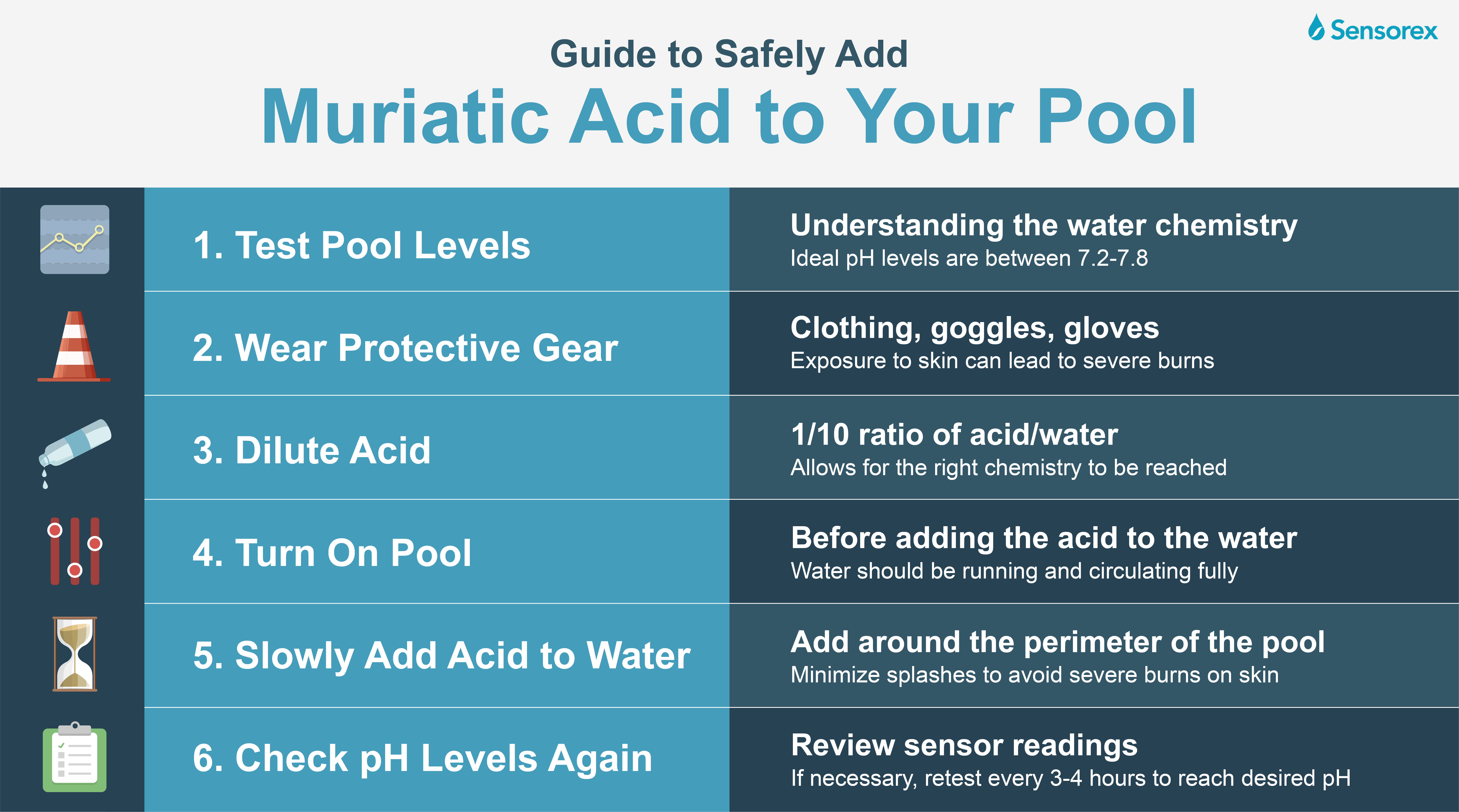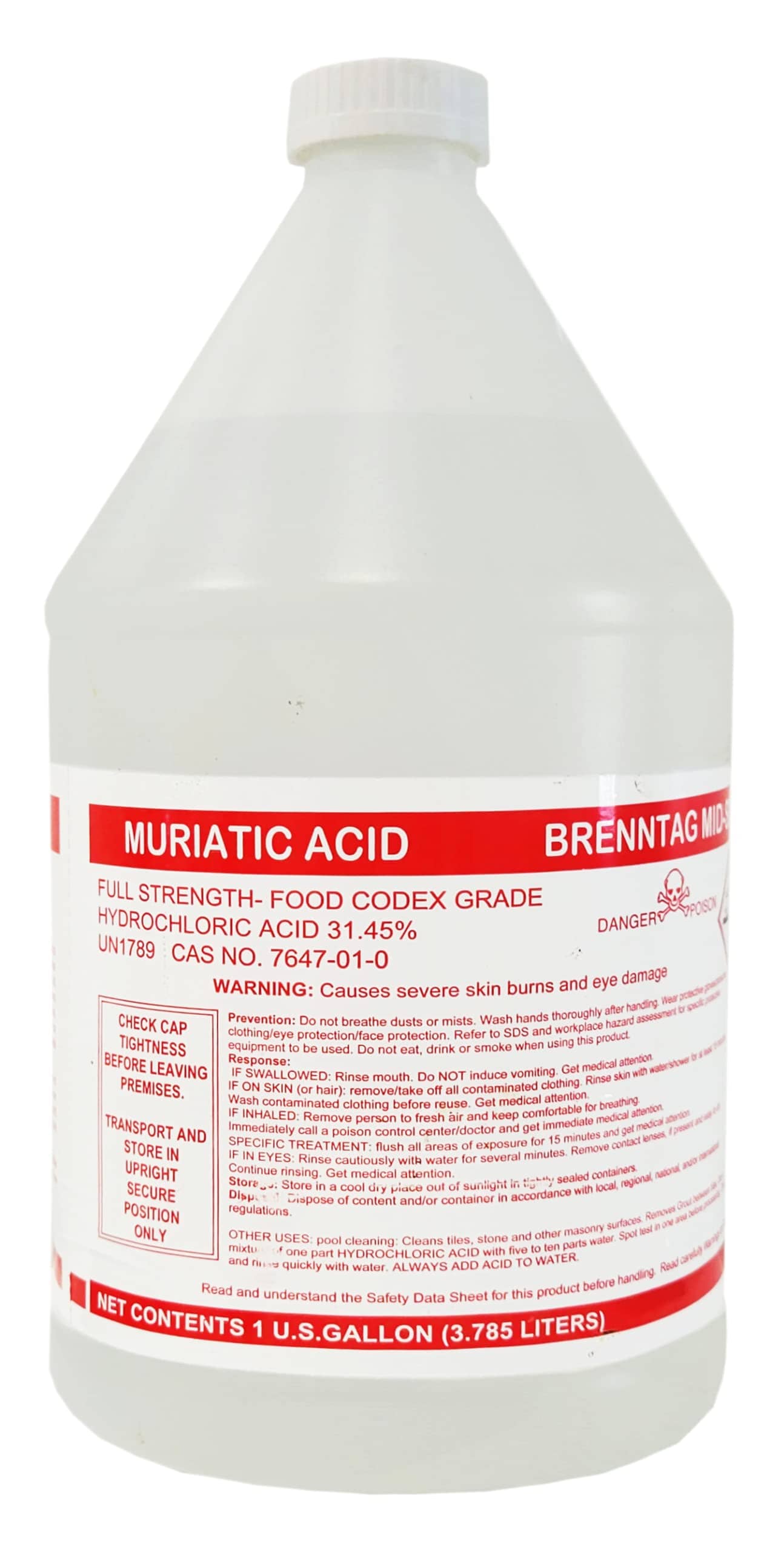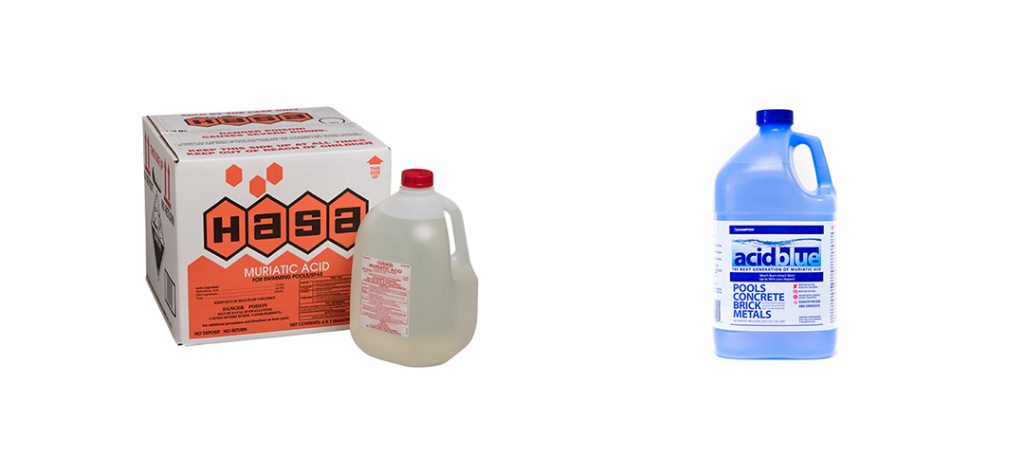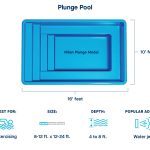Muriatic acid is used to lower the pH levels in a pool, making the water more balanced and safer for swimmers. It helps maintain optimal chlorine effectiveness and prevents the growth of algae and bacteria, ensuring a clean and healthy swimming environment.
Having a well-maintained pool is essential for enjoyable and safe swimming experiences. One crucial aspect of pool maintenance is maintaining the correct pH levels. High pH levels can lead to cloudy water, scaling, and inefficient chlorine effectiveness, while low pH levels can cause skin and eye irritation.
This is where muriatic acid comes in. By adding muriatic acid to the pool, you can easily and effectively lower the pH levels, ensuring a well-balanced pool environment. We will explore the benefits of using muriatic acid for pool maintenance and provide tips on how to use it safely and effectively. So, let’s dive in and discover the wonders of muriatic acid for your pool.
Importance Of Muriatic Acid In Pool Maintenance
Muriatic acid plays a crucial role in maintaining a clean and healthy pool environment. Its significance in pool maintenance cannot be overstated. Controlling pH levels and preventing algae growth are just a few of the important aspects of using muriatic acid in pool maintenance.
Maintaining Optimal Ph Levels
The optimal pH levels in a pool are essential for ensuring the effectiveness of the chlorine and other sanitizers, as well as preventing scale formation and corrosion. Muriatic acid is used to lower the pH levels when they rise above the recommended range of 7.2 to 7.6. By adjusting the pH with muriatic acid, it helps to maintain a comfortable swimming environment and also prevents damage to pool equipment and surfaces.
Preventing Algae Growth
Algae growth can quickly turn a sparkling pool into a green, slimy mess. Muriatic acid, when used to maintain proper pH levels, helps in preventing algae growth. Algae thrives in higher pH environments, and by keeping the pH levels within the optimal range using muriatic acid, it significantly reduces the likelihood of algae taking hold in the pool.

Credit: sensorex.com
Understanding Ph Levels In Pools
Understanding pH Levels in Pools Maintaining the proper pH level in your pool is crucial for ensuring a safe and enjoyable swimming environment. The pH scale measures the acidity or alkalinity of the water, with a range of 0 to 14. A pH level of 7 is considered neutral, while anything below 7 is acidic and above 7 is alkaline.
The pH scale is a measure of the acidity or alkalinity of a substance, in this case, pool water. It is important to maintain the pH of your pool water between 7.2 and 7.8. This range is ideal for preventing issues like corrosion, cloudy water, and skin and eye irritation.
If the pH level of your pool water is not within the recommended range, it can lead to a range of issues. For instance, a low pH level can cause corrosion of metal equipment, such as ladders and pump parts. On the other hand, a high pH level can result in cloudy water and reduced effectiveness of chlorine. Additionally, high pH can also cause scale formation on pool surfaces, making them slippery and difficult to clean.
Applying Muriatic Acid Safely
Muriatic acid is essential for maintaining a clean and balanced pool. It effectively removes stains, scale, and mineral deposits, ensuring a safe and enjoyable swimming experience. Safely applying muriatic acid helps maintain the overall health and hygiene of the pool.
Recommended Safety Gear
Use protective eyewear to shield eyes from splashes. Wear gloves to prevent skin contact. Face mask or respirator to avoid inhaling fumes.
Proper Dilution Techniques
Dilute muriatic acid with water in a well-ventilated area. Slowly pour acid into water to prevent splashing. Mix thoroughly before adding to pool.

Credit: atlas-scientific.com
Testing Pool Water For Ph Levels
Maintaining optimal pH levels in a pool is crucial to ensure water clarity and safety. Testing pool water regularly for pH levels is essential in determining the right amount of muriatic acid needed. Muriatic acid helps in balancing pH levels by lowering alkalinity and preventing bacteria growth.
Using Pool Test Kits
Testing your pool water regularly is essential to maintaining a healthy and balanced swimming environment. One of the key factors to consider when testing your pool water is the pH level. pH measures the acidity or alkalinity of the water on a scale of 0 to 14, with 7 being neutral. It’s crucial to keep the pH level between 7.2 and 7.8 to ensure comfort for swimmers and protect your pool from damage.
Pool test kits are the perfect tool for accurately measuring the pH levels in your pool water. These kits typically come with test strips or liquid reagents that you can easily use to perform the test. Here’s a step-by-step guide on how to use a pool test kit:
- Dip a test strip or mix a liquid reagent with a water sample from your pool.
- Allow the strip to react or the liquid to change color according to the instructions provided.
- Compare the color of the test strip or the final color of the liquid with the provided chart.
| Color Range | pH Level |
|---|---|
| Yellow or Green | Low pH (acidic) |
| Red | High pH (alkaline) |
| Blue | Optimal pH level (7.2-7.8) |
By using a pool test kit, you can easily and accurately determine the pH level of your pool water.
Interpreting Test Results
Once you have obtained the test results for your pool water’s pH level, it’s crucial to interpret them correctly. The pH level will give you an indication of how acidic or alkaline your pool water is. Here’s how to interpret the test results:
- If the test indicates a low pH level (yellow or green color), it means the water is too acidic. This can cause irritation to swimmers’ eyes and skin, as well as damage to pool equipment and surfaces.
- If the test indicates a high pH level (red color), it means the water is too alkaline. Alkaline water can also cause irritation and cloudy water, as well as prevent chlorine and other pool chemicals from working effectively.
- If the test indicates an optimal pH level (blue color within the range of 7.2-7.8), it means your pool water is perfectly balanced and ready for swimming.
Based on the test results, you can take appropriate measures to adjust the pH level of your pool water. If it’s too acidic, you can increase the pH by adding a pH increaser like sodium carbonate. If it’s too alkaline, you can decrease the pH by adding a pH decreaser like muriatic acid.
Regularly testing and maintaining the pH level of your pool water will ensure a safe and enjoyable swimming experience for everyone.
Dosage And Frequency Of Muriatic Acid Use
Muriatic acid is used to lower the pH level of pool water and balance alkalinity. The dosage and frequency of its use depend on the pool’s size and the current pH level. It’s crucial to follow safety guidelines when handling and applying this acid to maintain a healthy pool environment.
Calculating Dosage For Pool Size
Muriatic acid is crucial for maintaining pH balance in pools. For accurate dosing, consider your pool’s size.
Weekly Maintenance Tips
- Test pool water weekly for pH levels
- Adjust muriatic acid dosage as needed
- Consistent maintenance helps prevent issues
Remember to wear protective gear whenever handling muriatic acid.
Alternative Methods For Ph Adjustment
When it comes to maintaining a clean and balanced pool, adjusting the pH levels is crucial. While muriatic acid is a popular choice for pH adjustment, there are alternative methods available. These methods provide effective results and offer a more convenient approach to pool maintenance. In this article, we will explore a couple of alternative methods for pH adjustment that are safe, affordable, and easy to use.
Using Baking Soda
One of the simplest and most eco-friendly methods of pH adjustment is by using baking soda. Available in most households, baking soda is a cost-effective solution that can be easily added to your pool water. Due to its alkaline nature, baking soda helps raise the pH levels in your pool, bringing it back to the optimal range of 7.2 to 7.6.
How do you use baking soda for pH adjustment? Here’s a step-by-step guide:
- Start by testing the current pH levels of your pool water using a reliable testing kit.
- If the pH levels are below the recommended range, calculate the amount of baking soda required to raise the pH. Typically, for every 10,000 gallons of water, you will need around 1.5 pounds of baking soda.
- Once you have determined the required amount of baking soda, slowly add it to the pool water. Make sure to distribute it evenly by pouring it in different areas of the pool.
- Use a pool brush or pool pole to circulate the water and facilitate the mixing of baking soda.
- After approximately 6 to 8 hours, retest the pH levels to ensure they have reached the optimal range. Repeat the process if necessary.
Baking soda is a safe and gentle alternative for pH adjustment. Its natural properties make it suitable for regular use without any harmful effects on swimmers or pool equipment. Plus, it’s readily available and affordable, making it a go-to option for many pool owners.
Considering Ph Increasers
If you prefer a more specialized approach to pH adjustment, you can consider using pH increasers. These products are formulated specifically for pool maintenance and provide a quick and accurate way to adjust pH levels.
Common pH increasers include sodium carbonate and sodium bicarbonate. These chemicals effectively raise the pH levels in your pool, restoring balance and preventing issues such as corrosion and scaling. Just like muriatic acid, pH increasers should be used in moderation and followed by regular testing to avoid overcorrection.
When using pH increasers, it is essential to carefully follow the manufacturer’s instructions. Typically, you will need to add the product directly to the pool water and allow it to circulate for a few hours before retesting the pH levels. Remember to handle these chemicals with caution and store them in a secure place away from children and pets.
By considering these alternative methods for pH adjustment, you can easily maintain the desired pH levels in your pool without relying solely on muriatic acid. Whether you choose baking soda or pH increasers, ensuring proper pH balance will help prolong the life of your pool equipment and provide a safe swimming environment for you and your loved ones.
Troubleshooting Common Ph Problems
Persistent High Ph Levels
Muriatic acid is an effective solution for maintaining the pH balance in your pool. However, sometimes, pool owners may encounter persistent high pH levels, which can lead to a variety of issues such as cloudy water, scaling, and reduced effectiveness of chlorine. When dealing with persistent high pH levels, it is crucial to address the root cause and take necessary actions to restore the balance.
Dealing With Ph Fluctuations
As a pool owner, you may experience fluctuations in pH levels, which can disrupt the overall water balance. It’s important to understand how to effectively manage these fluctuations to ensure a safe and enjoyable swimming environment. By implementing proper maintenance and utilizing muriatic acid as needed, you can effectively manage pH fluctuations and prevent potential problems.
Consulting A Professional For Pool Maintenance
Hiring A Pool Service Technician
When it comes to keeping your pool in pristine condition, hiring a pool service technician can be highly beneficial. These professionals are well-versed in the intricacies of pool maintenance and can efficiently handle various tasks, including balancing chemical levels, cleaning filters, and inspecting equipment.
Opting For Regular Maintenance Plans
Another option for homeowners is opting for regular maintenance plans with a reputable pool service company. This ensures that your pool receives consistent care, preventing issues from arising and maintaining water quality and clarity. Regular maintenance plans typically include cleaning, chemical treatments, and equipment inspections.

Credit: florida-sunseeker.myshopify.com
Conclusion
Maintaining a pool with muriatic acid is crucial for proper pH balance. It helps prevent algae growth and keeps water clear. By understanding its benefits, pool owners can ensure a safe and enjoyable swimming experience. Regular use of muriatic acid is key to a well-maintained pool.





